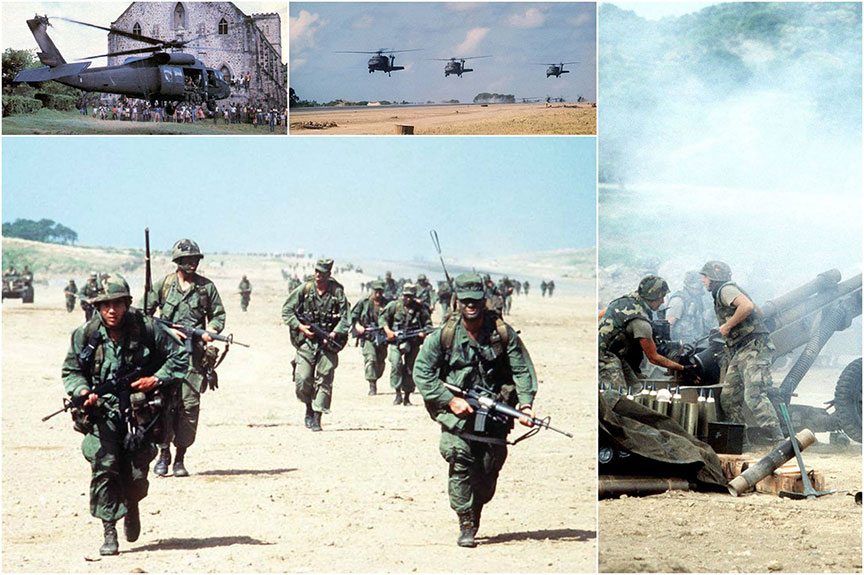
In 1983, Prime Minister Maurice Bishop of Grenada was placed under arrest by General Hudson Austin and Deputy Prime Minister Bernard Coard– both avowed Marxists. The United States feared that Grenada would become another Cuba. Under the guise of an invitation by the Organization of Eastern Caribbean States, US troops intervened and took control of the island. There were 1,100 American citizens on the island, including a large number of medical students. Ensuring the safety of those Americans was one of the professed goals of attack. Sixteen Americans were killed and 77 were injured in the military action..
Maurice Bishop came to power in Grenada in 1979 through a coup that ousted the corrupt and repressive government of Prime Minister Eric Gairy. Bishop's New Jewel Movement (NJM), a socialist party with Marxist leanings, promised to bring social justice, economic reforms, and an end to Gairy's authoritarian rule. Bishop was a charismatic leader, popular among Grenadians for his progressive policies, including improvements in healthcare, education, and infrastructure.
However, Bishop's government also aligned closely with communist countries, particularly Cuba and the Soviet Union, which provided financial and military aid to Grenada. This relationship alarmed the United States, which viewed any expansion of communism in the Western Hemisphere as a direct threat to its national security, especially in the context of the Cold War.
Despite Bishop's popularity, internal divisions within the NJM began to surface. A faction led by Deputy Prime Minister Bernard Coard, supported by General Hudson Austin, felt that Bishop was not moving fast enough toward establishing a fully Marxist state. They believed that Bishop's moderate approach was a betrayal of the revolution's principles.
Tensions came to a head in October 1983, when Coard and Austin orchestrated a coup. Bishop was placed under house arrest, sparking widespread protests among Grenadians who demanded his release. On October 19, 1983, Bishop was freed by a crowd of supporters, but this liberation was short-lived. He and several of his loyalists were captured and executed by the military, led by Austin and Coard, in a brutal crackdown that shocked the nation and the world.
The coup and the subsequent instability in Grenada alarmed the United States. The Reagan administration feared that Grenada, under its new Marxist leadership, would become another Cuba—a Soviet-aligned communist state in the Caribbean. This concern was exacerbated by the presence of Cuban military personnel on the island, ostensibly there to help build a new airport, which the U.S. suspected could be used as a Soviet military base.
Adding to these geopolitical concerns was the safety of approximately 1,100 American citizens on the island, including a large number of medical students at St. George's University. The U.S. government claimed that these Americans were in danger due to the escalating violence and uncertainty in Grenada. Although there were no reports of harm to the Americans at the time, the situation provided a convenient pretext for military action.
Under the guise of an invitation from the Organization of Eastern Caribbean States (OECS), the U.S., along with troops from Jamaica and other Caribbean nations, launched Operation Urgent Fury on October 25, 1983. The stated objectives were to restore order, protect American lives, and prevent Grenada from becoming a communist outpost.
The U.S. invasion was swift but met with unexpected resistance from Grenadian and Cuban forces on the island. The fighting lasted several days, during which 16 American soldiers were killed and 77 were injured. Despite these casualties, the U.S. forces quickly took control of the island, capturing key locations, including the capital, St. George's.
General Hudson Austin and Bernard Coard were arrested, and a new government was installed with U.S. backing. The invasion was controversial, with many countries, including some U.S. allies, condemning it as a violation of international law. The United Nations General Assembly also passed a resolution deploring the invasion, though it was largely symbolic.
For Grenada, the invasion marked a turning point. The island was placed under U.S. administration temporarily, and democratic elections were eventually held in 1984, bringing an end to the brief experiment with Marxist rule. The intervention solidified U.S. influence in the Caribbean and sent a clear message that the U.S. would not tolerate the spread of communism in its backyard.
The 1983 invasion of Grenada remains a significant event in the history of U.S. foreign policy, symbolizing the lengths to which the U.S. would go to counter perceived communist threats during the Cold War. While the invasion was portrayed as a rescue mission for American citizens, its true motivations were deeply entwined with the geopolitical struggle between the U.S. and the Soviet Union. The intervention also highlighted the vulnerability of small nations caught in the crossfire of global superpower rivalries.
For Grenada, the invasion led to a period of political stability and a return to democratic governance, though it also left lasting scars from the violence and upheaval. Maurice Bishop remains a revered figure in Grenada, remembered for his efforts to uplift the island's poor, even as the legacy of his government and the events of 1983 continue to be debated.
 >
>